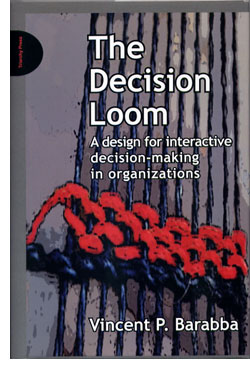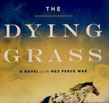 |
 |

Vincent P. Barabba
The Decision Loom: A Design for Interactive Decision-Making in Organizations
Triarchy Press
Uk Hardcover First Edition
ISBN 978-1-908-00945-6
Publication Date: 11-15-2011
288 Pages; $30
Date Reviewed: 03-16-2012
Reviewed by: Rick Kleffel © 2012
Index:
Non-Fiction
We're not the first generation to feel overwhelmed by the new, and we certainly won't be the last. What will distinguish each and every one of us is how we meet the incoming crush of novelty, how we decide what deserves our attention, what can be ignored and what to do having made those decisions. Vincent Barabba brings a wealth and a wide variety of experience to his book-length answer, 'The Decision Loom: A Design for Interactive Decision-Making in Organizations.'
Part of that experience gave him the ability to communicate what he learned as he worked within both public and private organizations, and 'The Decision Loom' addresses a very interesting question that does not get asked very often, and is answered even less so; How do we decide what to do in the face of an onslaught of tasks, data and potential that overwhelm us from the get-go? Barabba does not pretend to have all the answers, but he's damn good at asking the questions and the answers he does have are smart and flexible enough to be worth reading.
The book is divided into two parts; his experience ("The Journey") and his advice ("The Design of an Interactive Decision Loom"). His experience suggests he's the right man to ask and answer these questions. He's worked to measure voter sentiments in political campaigns, in the US Census under both Democratic and Republican administrations, and he's currently in the California Citizens Redistricting Commission. He developed OnStar while working at GM, and while working at Kodak, watched as they decided to use digital technology to improve their film process instead of replacing it. The first half of the book offers nine episodes across a spectrum of American employment, crisply described with his thesis in mind. By itself it involves readers in a vision of information, opportunity and decision unraveling across the last thirty or so years of the economic landscape.
Barabba follows up his first part with a chart that summarizes the general aspects of his experiences and cross-references them with the four capabilities he identifies in the second half of the book. These are not necessarily going to shock anyone who has worked for any length of time — they are, roughly, be open to change, think holistically, be able to adapt, and make decisions interactively. But his expression and his approach — to wit, the "decision loom" — have a fresh, yet vintage, almost steampunk appeal. To a degree, this could have been put together one hundred years ago. At least Barabba finally got round to it.
As he cycles through the four capabilities, he emphasizes an open mind and a nimble, humble approach. This is not the sort of book that needs to shout at you, nor does Barabba take the "baffle you with abstractions" path. The charts, the lessons, the stories and the theories are not there as the final end-all and be-all. They're intended to make you think about how such material might and might not be applicable in your situation, in your life. 'The Decision Loom' does not tell you what to decide. It suggests the means by which you may make a good decision. It's one of the few examples of data that is really worth searching for amidst the incoming waves of novelty that confront you every day, including this review.
|
 |
|
|
 |
| |
Review Archive
All Reviews alphabetized by author.
General Fiction
Non-Genre, general fiction and literature.
Horror
Supernatural fiction, supernatural horror and non-supernatural horror.
Science Fiction
Science fiction, science fantasy, speculative fiction, alternate history.
Fantasy
Fantasy, surrealism and magic realism.
Mystery
Crime, thrillers, mystery, suspense.
Non-Fiction
Non-Fiction, True Crime, Forteana, Reference.
Poetry
|
|
 |
|




